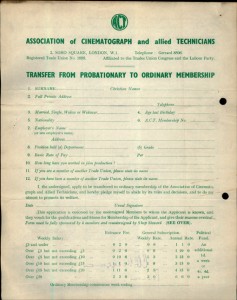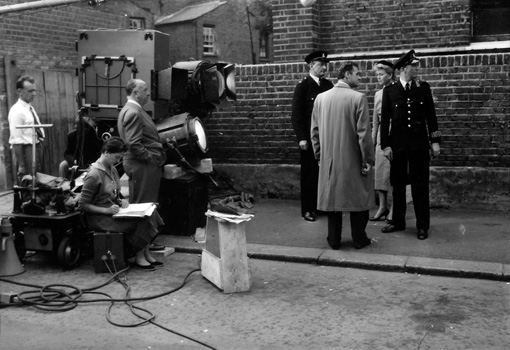Dr Melanie Bell-Williams provides an overview of a new research project on the history of women’s contribution to British film and television production.
About the author: Dr Melanie Bell-Williams is Senior Lecturer in Film at Newcastle University. Her primary research interest is the relationship between gender and film, with an emphasis on production, representation and consumption. Within the context of British film and cinema Dr Bell-Williams interested in women's involvement in the production process and questions of agency, gender and production cultures and textual femininities/screen representations of women. Her publications include: Femininity in the Frame: Women and 1950s British Popular Cinema (I.B. Tauris, 2010); Bell M, Williams M, eds. British Women's Cinema (Routledge, 2009); Julie Christie: Cinema, Stardom and Creative Control (BFI Palgrave Macmillan, 2015, forthcoming).
This three and a half-year AHRC-funded research project is investigating the contribution women have made to film and television production in Britain. It focuses on the period between 1933 and 1989, a time of considerable social change for women and substantial institutional change for the industries. The project started in January 2014. The research team brings together expertise in film history (Dr Melanie Bell) and oral history interviewing (Sue Bradley) at Newcastle University with television (Dr Vicky Ball) and union history (Frances Galt) at De Montfort University.
Thousands of women have contributed to film and television production in Britain. Those in the high-profile roles of director and producer are relatively well known (Muriel Box, Verity Lambert) but the majority of women have been employed in ‘below-the-line’ roles: hairdressers, continuity ‘girls’, production assistants, negative cutters. These ‘auxiliary’ roles, described by Sally Potter as ‘invisible labour’, are notoriously difficult to research and as a result the history of these women has barely been studied. Much of their work has been further undervalued by academic scholarship that has privileged auteur-directors, and its study hampered by scarce archival sources. This ambitious new project draws on trade union records and oral history testimony to investigate the role women played in shaping the output of these two major creative industries. From 1933 to 1989 film and commercial TV operated as a closed shop and BBC employment was similarly regulated. By tracing women’s contribution through union membership data this project will provide empirical evidence about the number of women who worked in the industries, their roles and their movement between film and television. This data will be supplemented by oral history interviews with women, which explore their working lives. In bringing these two approaches together this project will unlock previously hidden evidence about women’s work - its diversity and historical variability - and develop new ways of conceptualising and historicising the film and television industries through the experiences of below-the-line workers. This will have a wider impact on both the study of film and television and our understanding of the role of women in twentieth-century creative arts/industries.
The focus of this research is timely. The UK has the largest creative sector within the European Union and its industries are major employers. Recent reports however highlight the small number of women currently occupying senior roles in film and television, and a high attrition rate among the female workforce. Employment pathways, traditions and cultures develop over time. Knowing more about what these were like in the past will help us to understand their legacies and their impact on women working in film and television today. The project team are working in partnership with BECTU, the Broadcasting, Entertainment, Cinematograph and Theatre Union, and the British Universities Film & Video Council (BUFVC) and its Head of Research, Linda Kaye. Through this partnership the project will deliver one of its major outputs; a database and contextual website comprising union membership materials (approximately 67,000 records) and oral history interviews with women. This will be published on the BUFVC’s website and will be available to the public and scholars for future research.

Kay Mander filming HOW TO FILE (1941) from the Panamint DVD release, ONE CONTINUOUS TAKE: THE KAY MANDER STORY (image courtesy of Panamint).
Objectives The four principle objectives of the project are:
- To identify how many women worked in the British film and television industries between 1933 and 1989, and the range of roles in which they were employed. Here the team will draw on union membership records and BBC staff lists to produce a quantitative survey of women’s labour.
- To explore women’s experiences in film and television production. Oral history interviewing will be the principle means through which the team will engage in dialogue with women practitioners, exploring the material texture of their working lives and the production cultures in which they worked and helped to shape.
- To produce case studies of key industry grades and production areas, and look at women’s contributions to that grade. Here the team are particularly interested to explore roles, which have received relatively little scholarly interest to date - wardrobe and make-up for example – and women’s work in regional ITV companies and BBC production centres.
- To create a sustainable resource which draws together statistical data and qualitative material which will be of interest to a wide range of people including researchers of media, labour and social history, archivists, practitioners working in the creative industries and their representative bodies.

Page from an application form to join the Association of Cinematograph and allied Technicians (ACT) from the 1950s.
Preliminary Findings In the first six months of the project the team have been working to identify potential candidates for interview. Notices about the project were placed in industry/trade newspapers, journals and websites. These generated responses from a diverse range of women who had worked in film and television production: production assistants, editors, researchers, PAs, wardrobe assistants, make-up artists, producers and others. The team have heard from women who worked across advertising, commercials and television, who switched from costume design to casting, and who worked in regional newsrooms. Women have told us about the technical equipment they worked with, the training they received, the friends they made, the money they earned, how they spent it and who made the tea. Although the project is still in its early stages preliminary research has opened up not only gendered but also regional and working-class perspectives on production, which challenge the existing histories written predominantly from white, southern, and middle-class perspectives.
The project will interview about twenty-five women. These interviews take a ‘life story’ approach; interviewing over several sittings and exploring themes of upbringing, education and home, as well as focussing in depth on work and the everyday work experience. This approach will produce a richly-textured and multi-faceted personal narrative with considerable research potential for current and future projects. The project will generate approximately 150 hours of recorded material, which will be preserved on the resource created by the BUFVC.
Delivering content online One of the project’s major outputs is a digital resource and here the project team are working closely with the BUFVC who are leading on developing the technical specification. At the core of this resource are the membership application records made to the film and television trade union BECTU (known as ‘ACT’ and ‘ACTT’ in earlier incarnations). These extant records are complete for the period 1933 to 1989 and provide a unique picture of employment in the British film and television industries. The ‘closed shop’ nature of the industries meant that all employees applied for a union ticket, thus the ‘great and the good’ – David Lean, Joseph Losey, Muriel Box – applied for membership alongside their less well-known co-workers. Furthermore as the union’s structure covered not only film production (shorts, documentary, features, newsreels) and independent television but also the laboratory branch, the records provide unique access to a sector of the industry which to date has received relatively little scholarly interest.
The resource created by BUFVC will host both scanned copies of all 67,000 membership applications and a fully-searchable database of specified core fields including gender, grade, employer, rate of pay and date of application. Including men as well as women not only allows comparisons by gender to be made, but preserves the integrity of the collection and ensures its value for future research projects. In addition to the membership applications the resource will also host the twenty-five oral history interviews. These will be fully searchable on-line with synchronous transcriptions i.e. rolling text will be visible as the words are spoken. The oral history material will be accompanied by a comprehensive index, narrative summaries and navigational brochure. These two collections will be integrated within a website comprising historical context and research case studies written by the research team.

Connie Willis (seated, left) working as continuity ‘girl’ on the set of THE MAN WHO KNEW TOO MUCH (1956), directed by Alfred Hitchcock (standing next to the camera) and co-starring Doris Day (standing, right). Photo courtesy of The Cinema Museum.
Challenges and progress to date The majority of the membership forms are hand-written paper applications in varying states of repair. Some of the material from the 1930s is particularly fragile, misspellings and inconsistencies occur and the application form itself underwent a number of format changes. These anomalies have presented the research team with a number of questions and challenges. To what extent should inconsistencies be ‘regularised’ or misspellings corrected? Should a controlled vocabulary be created across the employer field to regularise different variants of e.g. ‘BBC’ (B.B.C.; British Broadcasting) or ‘Pathe’ (Pathe Labs; Pathe Labs Ltd)? To what extent does regularisation introduce new hierarchies into the collection? Thinking about users of the resource and balancing their anticipated needs against the archival principles of record preservation have been a central part of the research team’s discussions.
Other outputs and developments Alongside the digital resource are the more conventional academic outputs which will include journal articles, conference papers and a monograph Behind the Screens: Women in British Film and Television Production, 1933-1989. The project’s website will include case studies and blogs reflecting on the experience of producing a history of women’s work, and the materials and methods deployed in the process. On 24 October 2014 the research team will be hosting an oral history symposium at Newcastle University to discuss some of the issues germane to the project such as narrative interviewing, memory and visual cultures. Speakers include Professor Lynn Abrams (Glasgow) and Dr Penny Tinkler (Manchester). A CD of extracts from the oral history recordings will be published in 2016 to promote the project and enhance understanding of the history of women’s work in the industries. The project team will also work closely with BECTU’s Training and Diversity officers to develop training tools around the oral history interview material, integrating it into a resource to be used in training workshops. Current industry practitioners face a range of issues and challenges in their professional lives and engaging with the experiences of past employees through the spoken word has proven an effective mechanism for generating discussion of, and reflection on, issues of equality and diversity in the workplace. Finally the project will host a major international conference in May 2016 which will draw together academics, archivists, curators, industry groups and policy-makers to debate key issues relating to women in film and television production both past, present and future.
For more information about the project please see the project website (http://research.ncl.ac.uk/womensworkftvi/). For information about the Oral History symposium or any other enquiries relating to the research, please contact Dr Melanie Bell (melanie.bell@ncl.ac.uk).
Dr Melanie Bell-Williams
 BUFVC update
The BUFVC’s role in this project is to manage the digital workstream, from assessing the collection in storage through digitization to development final online resource.
BUFVC update
The BUFVC’s role in this project is to manage the digital workstream, from assessing the collection in storage through digitization to development final online resource.
We are currently in the final stages of digitising the 67,000 union application forms along with the transcription of seven fields: gender, employer, salary, position – department and grade, date of application (or acceptance into the union if blank) and membership number. These will then be exported into a database and incorporated into our beta search interface. During the autumn we will work with the research team to refine this and develop a series of dynamic data visualisations.
The collection has presented a series of challenges particularly in regard to the personal nature of the material. We have had to balance the demands of data protection with online publication and this has necessitated some compromise with regard to access. Our agreement with BECTU only allows for access from higher & further education institutions in the UK with publication only possible with redaction of personal data such as the address.
Although we are just in the initial stages of development, the digitisation process has revealed the existence of different types of applications from probationary and ‘war emergency’ forms to those designed specifically for companies such as Kodak or areas of work, such as cable television. Indeed the changing format of the form from 1933 to 1989 reveals much about the evolving nature of the film and television industries and the role of the union within them.
Linda Kaye BUFVC Head of research